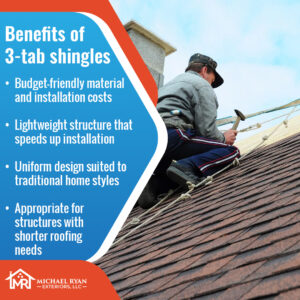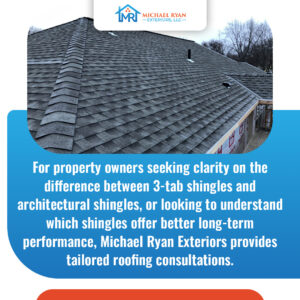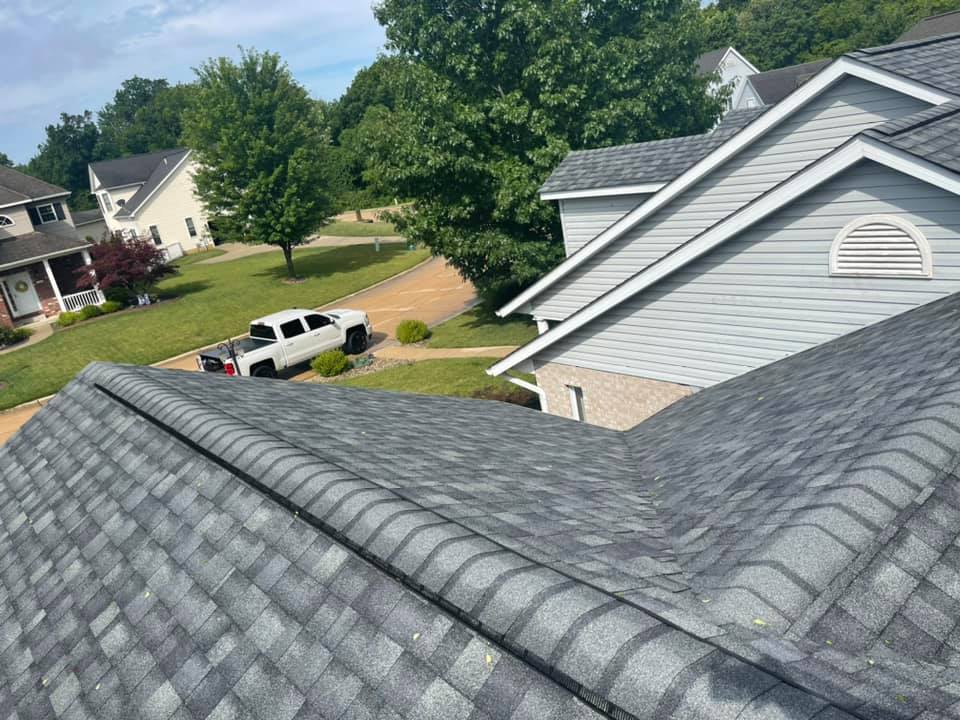Selecting the right roofing solution begins with understanding how local conditions affect long-term performance. At Michael Ryan Exteriors – Roofing Professionals, we understand the roofing challenges homeowners face in Edwardsville, Glen Carbon, and Troy. This region experiences a wide range of weather conditions, from strong winds and heavy rain to snow and seasonal temperature swings. These factors make roof durability an important part of any roofing decision.
Choosing the right shingles helps protect the home, manage energy use, and reduce the need for repairs. Knowing how to compare asphalt shingles types and understand different shingle grades allows homeowners to make informed, practical choices. Shingle grades play a key role in determining the overall lifespan, performance, and maintenance requirements of a roof.

3-Tab vs. Architectural Shingles
Homeowners often want to know how 3-tab shingles differ from architectural shingles in terms of lifespan, strength, and appearance. The right choice depends on factors like roof slope, overall design goals, material quality, and budget. Traditional 3-tab shingles are known for their clean, uniform look and lower cost, making them a practical option for simpler projects. Architectural shingles, also referred to as dimensional or laminate shingles, are built with multiple layers that create a textured, high-performance finish. This layered design adds strength, enhances curb appeal, and offers better resistance to harsh weather.
By understanding these differences and selecting the right match for your home’s structure and style, you can achieve a durable, cost-effective roofing solution. Michael Ryan Exteriors works closely with homeowners throughout Edwardsville, IL, to recommend the best asphalt shingles based on local weather patterns, home design, and long-term goals.
What Are Shingle Grades
When selecting roofing materials, understanding shingle grades is key to evaluating durability, build quality, and performance. Shingle grades refer to the material thickness, weight, and weather-handling capability of asphalt shingles. Higher-grade shingles are typically made with multiple layers for improved strength and longer use, while basic-grade options focus on affordability and basic protection.
Among the most widely used asphalt shingles types are 3-tab shingles, dimensional shingles, and premium varieties. Each type fits different design goals and budgets. The most common roofing comparison is Architectural Shingles vs 3-Tab, a topic that continues to interest homeowners researching long-term value and appearance. These styles are also referred to as dimensional shingles vs 3-tab and laminate shingles vs 3-tab, depending on how the shingles are marketed and constructed.
Shingle Grades: 3-Tab vs Architectural
When comparing shingle types, several factors come into play, such as material thickness, wind resistance, and overall appearance. A 3-tab shingle is part of the basic shingle grades, made with a single asphalt layer and evenly spaced cutouts that create a flat, consistent look. These shingles are commonly used in roofing projects that focus on affordability and simplicity. In contrast, 3-dimensional shingles, often referred to as architectural shingles, have a layered structure that adds strength, depth, and visual appeal. These belong to a higher category within asphalt shingles types, offering improved surface durability and better performance under changing weather conditions.
Higher shingle grades, like those used in laminate shingles vs 3-tab systems, are often selected for homes in regions with varying climates and more demanding roof requirements. The following sections will explore how architectural shingles and 3-tab shingles differ in structure and performance, highlighting the advantages and drawbacks of each to help homeowners in Edwardsville, IL, choose the right roofing option based on design preferences, local weather conditions, and budget.
Pros and Cons of 3-Tab Shingles
Understanding the pros and cons of 3-tab shingles can help homeowners decide if this basic option meets their roofing needs, budget, and design preferences.
Pros of 3-Tab Shingles
While architectural shingles offer enhanced durability and design, many homeowners still consider 3-tab shingles for their affordability and practicality. Below are the key benefits that make them a common choice among basic asphalt shingles types.
1. Budget-Friendly
3-tab shingles are one of the most cost-effective roofing materials available. This makes them a popular choice for homeowners working within a tight budget. They are commonly used on starter homes, sheds, and other basic structures where material cost is a key concern.
2. Easy Installation
Because a 3-tab shingle consists of a single asphalt layer, it is lighter and easier to handle during installation. This can reduce labor time and simplify the process for contractors. For homeowners, this often means faster project completion and fewer labor-related charges.
3. Consistent Design
3-tab shingles provide a flat, consistent appearance that gives roofs a uniform finish. This simplicity works well with traditional home designs and basic rooflines. It’s a good fit for homeowners who prefer a straightforward, no-frills look.
4. Good for short-term use
Temporary structures, secondary properties, and rental units can benefit from the practical value that 3-tab shingles offer. While they may not be a long-term solution, they perform adequately for moderate usage.
Cons of 3-Tab Shingles
Despite their advantages, the 3-tab shingle has several limitations that may affect long-term roofing performance and design flexibility.
1. Shorter Lifespan
Most 3-tab shingles remain functional between 15 and 20 years under normal conditions. This is shorter than the usage period provided by materials in higher shingle grades. As a result, homeowners may need to replace them sooner than expected.
2. Lower resistance to weather
The single-layer design makes 3-tab shingles more vulnerable to damage from wind, rain, and UV exposure. They are more prone to curling, cracking, or being lifted by high winds. In severe weather regions, this can affect the roof’s durability over time.
3. Limited design options
Compared to 3-dimensional shingles, 3-tab shingles come in fewer colors and styles. This limits visual flexibility when trying to match a roof with specific exterior features. For design-conscious homeowners, the available selections may feel restrictive.
4. Entry-Level Option
In terms of shingle grades, 3-tab shingles are considered an entry-level product. They are made with fewer layers and offer fewer enhancements than higher-tier options. This makes them less suitable for projects where durability and material quality are a priority.
Michael Ryan Exteriors installs and replaces 3-tab shingles for residential and commercial properties across Edwardsville, Glen Carbon, Troy, and surrounding Illinois communities, delivering roofing solutions tailored to function, timeline, and budget.
A Closer Look at Architectural Asphalt Shingles
Architectural shingles, also known as dimensional shingles or laminate shingles, are a step up from traditional 3-tab shingles in both performance and appearance. These shingles are constructed from multiple layers of asphalt, giving them added thickness and a more defined, dimensional look. Their design not only enhances curb appeal but also improves resistance to wind, impact, and moisture.
When evaluating dimensional shingles vs 3-tab, architectural shingles offer greater structural integrity and better protection against severe weather. This makes them a preferred choice among asphalt shingles types for homeowners who want a balance between durability and aesthetics.
Roofing That Delivers Strength and Value
As part of higher-tier shingle grades, architectural shingles are designed to outperform basic materials like the 3-tab shingle. They generally function for 25 to 30 years or more with proper care, making them a solid investment in both function and exterior style. Compared to 3-dimensional shingles, which share similar visual appeal but vary in construction depending on the manufacturer, architectural shingles are widely recognized for consistent build quality. They are also available in a broader range of colors and textures, offering more flexibility in achieving the desired exterior look. Due to their layered construction, they are heavier than standard 3-tab products and should be installed by experienced roofing professionals to meet material specifications.
Key Benefits of Architectural Shingles
Architectural shingles are seeing growing demand nationwide due to their superior durability, enhanced wind resistance, and visually appealing design. According to reports by Research and Markets, the Roofing Market was valued at USD 213.76 billion in 2023, and is expected to reach USD 280.29 billion by 2029, rising at a CAGR of 4.62%.
Below are some of the most recognized benefits that make architectural shingles a preferred option among higher shingle grades.
1. Increased durability
Architectural shingles are built with a thicker, layered composition that improves resistance to wind, impact, and roof stress. This multi-layer structure reinforces the surface, reducing the likelihood of cracking over time. It also adds dimensional stability, allowing the shingles to maintain their shape under varying temperatures. For homeowners in areas with unpredictable weather conditions, this added durability offers reliable performance throughout the year.
2. Extended Roof Life
Architectural shingles typically perform for 25 to 30 years, far exceeding the lifespan of most 3-tab shingles. They are manufactured to withstand long-term exposure to the elements without experiencing rapid granule loss. Their layered construction slows down aging and minimizes the need for frequent repairs or premature replacement. This extended performance cycle makes them a practical and cost-effective choice throughout the roof’s use.
According to EcoWatch, dimensional shingles have a projected lifespan of 30 years, but in some cases, they can last for more than 50 years. Due to their extended lifespan, architectural shingles have an excellent return on investment (ROI) — 60% to 70%.
3. Enhanced curb appeal
Architectural shingles are designed to replicate the look of high-end materials such as wood shake or slate, giving homes a more textured and upscale appearance. Their added depth and shadow lines create a refined, dimensional finish that elevates the overall look of the roof. These shingles work well with a wide variety of home designs, from traditional to contemporary styles, and their dimensional profile enhances the roofline to improve the home’s exterior visual value.
4. Improved weather performance
Compared to single-layer shingles, architectural shingles offer stronger resistance to rain, snow, and high winds. Their added weight and adhesive sealing help them remain securely in place during storms and other weather events. Multiple bonded layers reduce the risk of moisture infiltration, making these shingles a dependable choice for homes located in regions with seasonal weather fluctuations.
As stated by the Federal Emergency Management Agency(FEMA), to reduce wind damage to asphalt shingles, FEMA recommends the use of Class F-rated shingles as determined by ASTM International (ASTM) D3161 or Class H-rated shingles as determined by ASTM D7158.
5. Broader design range
Architectural shingles are available in a wider selection of colors and patterns than standard 3-tab shingle products. Homeowners can choose textures that resemble slate, cedar shake, or other natural materials to match their home’s exterior better. With options that include color blends and unique granule finishes, these shingles offer greater flexibility in roof design while supporting both visual appeal and property value.
6. Lower maintenance needs
Due to their multi-layered construction and better material quality, architectural shingles require fewer repairs over time. They are less prone to curling, tearing, and granule loss. This makes them a lower-maintenance option for long-term roofing plans.
Michael Ryan Exteriors installs premium roofing systems using architectural shingles. It helps clients select the best roofing shingles Edwardsville, IL has to offer, matched to their design preferences, performance needs, and long-term value.
Limitations of Architectural Shingles
While architectural shingles offer enhanced durability and aesthetics, there are a few factors that homeowners should consider before selecting this roofing option.
1. Higher initial cost
Architectural shingles typically cost more than 3-tab shingles, both in materials and installation. The extra layers and added weight contribute to that increase. However, many homeowners view the upfront expense as a tradeoff for improved performance and appearance.
2. Heavier material
The additional layers make architectural shingles heavier than single-layer alternatives. In some cases, the roof structure may need to be reviewed to confirm it can support the added load. This can introduce extra preparation time before installation.
3. Longer installation process
The thickness and dimensional design of architectural shingles contribute to a longer installation process. Contractors must follow specific steps to align the patterns correctly and secure each layer. As a result, these shingles are better suited for experienced roofing professionals.
Frequently Asked Questions (FAQs)
1. What is the difference between 3-tab and architectural shingles?
3-tab shingles are single-layer, flat-profile shingles that offer affordability and a clean appearance. Architectural shingles, also known as dimensional or laminate shingles, are multi-layered and provide better durability, depth, and weather resistance. The choice often depends on project budget, expected roof life, and design preferences.
2. How do I choose the right shingle grade for my roof?
Shingle grade is based on thickness, layering, and performance. Entry-level grades like 3-tab shingles offer simplicity and cost-efficiency, while higher shingle grades like architectural shingles provide better durability, longer use, and more design options.
3. What happens if I install new shingles over an old roof?
Layering new shingles over old ones might seem cost-effective, but it can shorten the new roof’s life and hide underlying issues like rot or poor ventilation. This shortcut can lead to water damage or structural problems. Michael Ryan Exteriors conducts thorough roof inspections to determine the safest and most cost-effective installation method.

Architectural or 3-Tab? Trust Michael Ryan Exteriors in Edwardsville, IL
Choosing between 3-tab and architectural shingles ultimately comes down to your project’s priorities, whether that’s budget, durability, or long-term performance. Architectural shingles continue to gain popularity for their superior wind resistance, layered design, and extended lifespan, especially in areas like Edwardsville, Glen Carbon, and Troy, where seasonal weather can be unpredictable.
At Michael Ryan Exteriors, we guide homeowners in selecting roofing materials that align with their needs and goals. With increasing interest in impact-rated and energy-efficient roofing systems, now is an ideal time to explore shingle options that add both protection and value to your home. To learn more or request a detailed roofing estimate, contact Michael Ryan Exteriors at (618) 600-3490 or email office@MichaelRyanExteriors.com.


